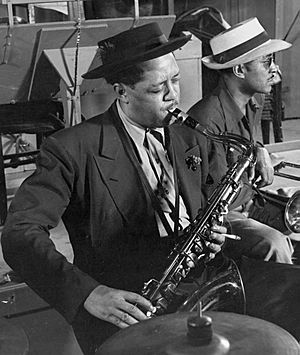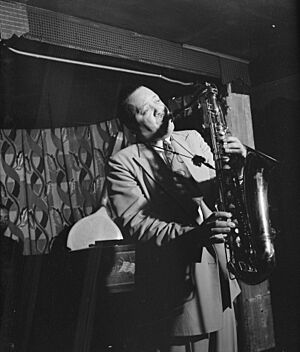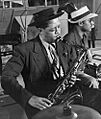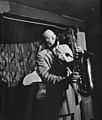Lester Young facts for kids
Quick facts for kids
Lester Young
|
|
|---|---|

Young (left) in 1944
|
|
| Background information | |
| Birth name | Lester Willis Young |
| Also known as | "Pres" or "Prez" |
| Born | August 27, 1909 Woodville, Mississippi, U.S. |
| Died | March 15, 1959 (aged 49) New York City, U.S. |
| Genres | Jazz |
| Occupation(s) | Musician |
| Instruments | Tenor saxophone, alto saxophone, clarinet |
| Years active | 1933–1959 |
| Labels |
|
| Associated acts |
|
Lester Willis Young (born August 27, 1909 – died March 15, 1959), known as "Pres" or "Prez," was an American jazz musician. He was famous for playing the tenor saxophone and sometimes the clarinet.
Lester Young became well-known when he played with Count Basie's orchestra. He was one of the most important saxophone players of his time. Unlike many other musicians who played very powerfully, Young had a calm, cool sound. He used clever musical ideas, making his music flow freely, like a bird soaring and diving. His style made both dancers and listeners happy.
He was also known for his unique, quiet personality. He even helped create or make popular many of the cool words and phrases used by jazz fans in the 1940s.
Contents
Early Life and Musical Start
Lester Young was born in Woodville, Mississippi, on August 27, 1909. His parents were Lizetta Young and Willis Handy Young, who was a band leader. Lester grew up in a musical family with his brother, Lee Young, who became a drummer, and his sister, Irma.
When he was young, living in New Orleans, he started working at age five to help his family. He sold newspapers and shined shoes. By the time he was ten, he had learned to play the trumpet, violin, and drums. He joined the Young Family Band and toured with carnivals, playing in cities across the Southwest.
As a teenager, Lester often left home for long periods. His family moved to Minneapolis in 1919. Young spent much of the 1920s there, where he first started playing the tenor saxophone. In 1927, at age 18, Young left the family band for good. He did not want to tour in the Southern United States because of the Jim Crow laws, which forced racial segregation. He then joined a band called the Bostonians and chose the tenor saxophone as his main instrument. In 1932, he joined the Oklahoma City Blue Devils band, led by Walter Page.
Playing with Count Basie
In 1933, Young moved to Kansas City, Missouri. After playing with a few bands, he became famous with Count Basie's orchestra. His playing in Basie's band was relaxed, which was different from the strong style of Coleman Hawkins, another popular tenor sax player. One of Young's big inspirations was Frankie Trumbauer, who played the C-melody saxophone.
Young left Basie's band for a short time to play with Fletcher Henderson's orchestra. He then played with the Andy Kirk band before returning to Count Basie. While with Basie, Young made recordings for Milt Gabler's Commodore Records. These were called The Kansas City Sessions. He played both clarinet and tenor saxophone in these recordings.
Lester Young also met and played with the famous singer Billie Holiday. They became very good friends. Billie gave Lester the nickname "Prez," short for President, because she thought he was the "greatest man around." In return, he called her "Lady Day." They made many classic recordings together. After his clarinet was stolen in 1939, Young stopped playing it until around 1957.
After Basie's Band
Young left the Basie band in late 1940. He then led several small music groups, often with his brother, drummer Lee Young. You can still find recordings from this time.
During this period, Young also recorded with Billie Holiday and Nat King Cole. There were fewer studio recordings between 1942 and 1943 because of a ban on recording by musicians. However, Young did record some sessions for Harry Lim's Keynote label in 1943.
In December 1943, Young rejoined the Basie band for about ten months. This time was cut short when he was called to serve in the army during World War II. Recordings from this time show that Young started using a plastic reed more often. This gave his playing a slightly heavier, breathier sound, though it was still smooth. In August 1944, Young appeared in a short film called Jammin' the Blues.
Army Service
In September 1944, Lester Young and Jo Jones were called into the U.S. Army. Unlike some musicians who joined special army bands, Young was assigned to regular duties. This meant he was not allowed to play his saxophone. He served for one year and finished his service in late 1945. His time in the army inspired his song "D.B. Blues."
Recordings After the War
After World War II, Young's career became even busier and more successful. He made many more recordings and performed live often. In 1946, Young joined Norman Granz's Jazz at the Philharmonic group. He toured with them regularly for the next 12 years. He also made many studio recordings with Granz, including more trio recordings with Nat King Cole. Young also recorded for Aladdin Records and Savoy in the late 1940s.
Challenges and Comeback
Around 1951, Lester Young faced some health challenges. His playing style changed, and he sometimes repeated musical phrases instead of creating new ones. He even called this being a "repeater pencil." Young's health became difficult, and in November 1955, he needed to go to the hospital to recover.
After this time, he felt much better. In January 1956, he recorded two sessions with old friends like pianist Teddy Wilson and trumpet player Roy Eldridge. These recordings became the albums The Jazz Giants '56 and Pres and Teddy. 1956 was a good year for Lester Young. He toured Europe with Miles Davis and the Modern Jazz Quartet and had successful performances in Washington, DC.
Young also sometimes played as a special guest with the Count Basie Orchestra. One famous performance was in July 1957 at the Newport Jazz Festival. He played with many of his friends from the 1940s, including Jo Jones and Roy Eldridge.
Family Life
Lester Young was married three times. His first marriage was to Beatrice Tolliver in 1930. His second wife was Mary Dale.
His third wife was Mary Berkeley. They had two children: Lester W. Young Jr. (born 1947) and Yvette Young (born 1957). Both of his children later earned advanced degrees in Education.
Final Years
On December 8, 1957, Young appeared on a TV show called The Sound of Jazz. He performed with Billie Holiday, Coleman Hawkins, and other famous musicians. It was a special reunion with Billie Holiday. Even though both were facing challenges, they gave very emotional performances. Many people said Young's solo was amazing, full of feeling and skill.
Lester Young made his last studio recordings and live performances in Paris in March 1959. He passed away early in the morning on March 15, 1959, at the age of 49.
How Lester Young Influenced Others
Lester Young's unique playing style had a big impact on many other saxophone players. These included Stan Getz, Zoot Sims, Al Cohn, and Warne Marsh. Even baritone saxophonist Gerry Mulligan and alto saxophonists Lee Konitz and Paul Desmond were influenced by him. Paul Quinichette copied Young's style so well that he was sometimes called the "Vice Prez." Lester Young also directly influenced a young Charlie Parker, who became a leader in the be-bop jazz style.
His Impact Beyond Music
Lester Young is believed to have helped make the word "cool" popular to mean something fashionable or great. He is also said to have popularized the slang term "bread" for money. He would ask, "How does the bread smell?" when he wanted to know how much a music job would pay.
Remembering Lester Young
Many artists have honored Lester Young after his death.
- Charles Mingus wrote a song for him called "Goodbye Pork Pie Hat" just a few months after Young passed away.
- Wayne Shorter composed a tribute song called "Lester Left Town."
- In 1981, OyamO (Charles F. Gordon) wrote a book about Young's life called The Resurrection of Lady Lester.
- The 1986 film Round Midnight had a main character partly based on Lester Young.
- English writer Geoff Dyer's 1991 book about jazz, But Beautiful, features Young as a major character.
- The 1994 documentary A Great Day in Harlem, about a famous photo of jazz musicians, includes many memories of Young. He was the first musician in that famous photo to pass away.
- Don Byron recorded an album called Ivey-Divey to show his thanks for what he learned from Young's music. "Ivey-Divey" was one of Lester Young's own unique phrases.
- A book of poetry called Prez. Homage to Lester Young (1993) was written by Jamie Reid.
- An opera about Young, Prez: A Jazz Opera, was broadcast by the BBC in 1985.
- Peter Straub's short story "Pork Pie Hat" (2000) tells a fictional story about Lester Young's life.
- On March 17, 2003, Lester Young was added to the ASCAP Jazz Wall of Fame. His children, Lester Young Jr. and Yvette Young, were there for the ceremony.
Recordings
Lester Young recorded many albums throughout his career, both as a leader and as a sideman with other famous musicians. Some of his notable recordings include:
- The Kansas City Sessions (recorded in 1938 and 1944)
- The Complete Aladdin Recordings (1942–47)
- The Complete Savoy Recordings (recorded 1944–50)
- The Complete Lester Young Studio Sessions on Verve (an 8-CD set)
He also appeared on many recordings with the Count Basie Orchestra, Jazz at the Philharmonic, and Billie Holiday.
Images for kids
See also
 In Spanish: Lester Young para niños
In Spanish: Lester Young para niños




